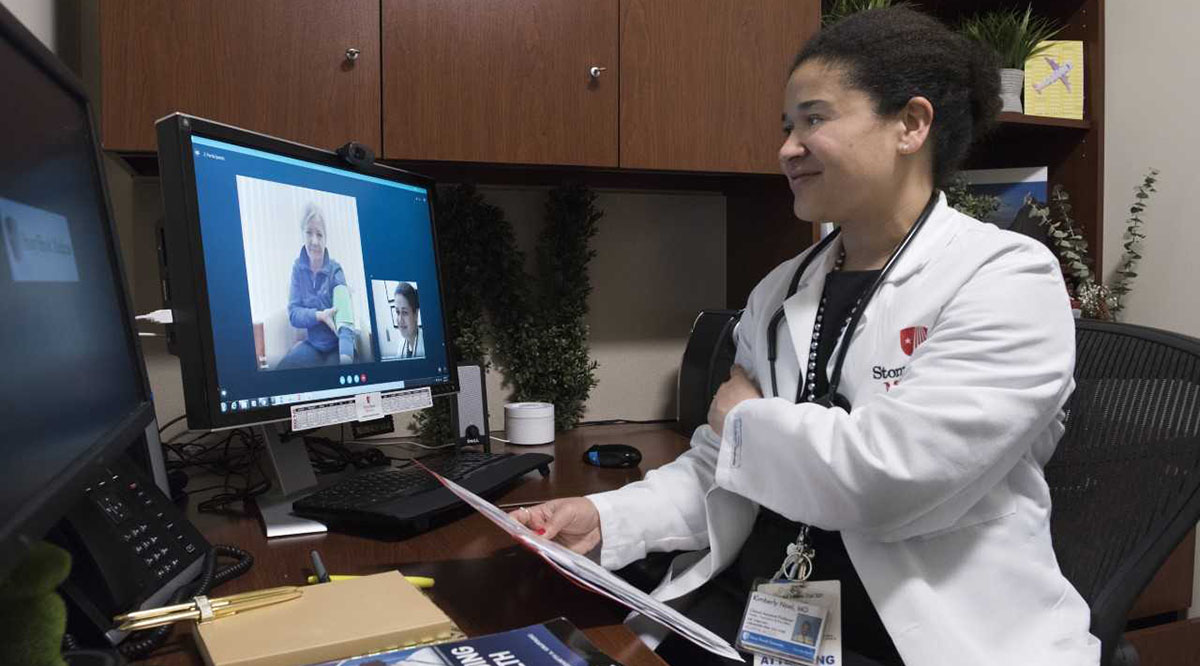
Editor's note: The opinions expressed by the author do not necessarily reflect the opinions of the AAMC or its members.
Telemedicine very likely saved my patient’s life.
Nathan Jones (not his real name) is 57 and had recently been hospitalized with the rare autoimmune condition dermatomyositis, which can cause a strange rash, muscle pains, and facial swelling. He’d also experienced difficulty swallowing.
Since going home, Mr. Jones had been diligently taking his medications, but when our telemedicine visit began, I noticed severe swelling around his lips. He also reported a strange phenomenon of his voice changing when lying flat.
Quickly, I instructed him to open his mouth, and I saw that his tongue was swollen. Concerned that his airway was closing, I immediately arranged for an ambulance to transfer him to the hospital. In less than an hour, Mr. Jones was in the care of our medical intensive care unit at Stony Brook University Hospital on Long Island, New York.
Without telemedicine, I might not have known about my patient's critical condition. Not one “to make fanfare,” Mr. Jones says he would never have sought an in-person medical appointment to address these pressing health issues — and his follow-up appointment was not for several weeks, which, in retrospect, would have been too late.
As telehealth director at Stony Brook Medicine, I was fortunate to know how to handle Mr. Jones’ dangerous condition remotely. But far too few medical students and physicians across the country learn such crucial skills.
That's a serious problem given telemedicine's explosion during the pandemic. As patients and practices opted for remote care to help prevent the spread of COVID-19, telehealth visits increased 154% in March 2020 compared to a year earlier, according to the Centers for Disease Control and Prevention.
Looking ahead, experts predict that telehealth will continue to grow in the years to come.
Medicare expanded payment for telemedicine during the pandemic, spurring interest in it, and some of that coverage has been made permanent. Patients appreciate remote care partly for its convenience. Health experts like it for many reasons, including that it offers a cost-effective way to triage patients. In addition, because it expands access to care, telehealth can help decrease hospital readmissions and unnecessary emergency department visits. And it reduces the risk of contracting a health care-related infection.
But telehealth needs to work well, and physicians need to know when its use is and is not appropriate. The medical community therefore has a duty to intensify its commitment to telehealth training. If we don’t have robust standards and education, we risk worsening the quality of patient care and perhaps even widening this country’s disturbing health disparities.
What every doctor needs to know about telemedicine
There are basic, essential skills every doctor needs if they’re going to practice quality remote care. The AAMC’s new report, Telehealth Competencies Across the Learning Continuum, can be extremely helpful in guiding educators and clinicians. (For more information, refer to the sidebar.)
Develop a “webside manner” and other basic skills.
Physicians must adapt the doctor-patient encounter for virtual practice to ensure the same quality of care — or higher — as an in-person visit. Because more than 80% of outpatient diagnoses are attributed to a thorough patient history, clinicians must make sure to take enough time and ask careful questions when collecting a medical history remotely.
A good “webside manner” is also essential. This includes maintaining consistent eye contact with the camera and using lighting that illuminates one’s face (known as “front-facing” lighting). Providers should practice telemedicine in a professional environment and take steps to ensure that a session isn’t interrupted by background noises or visual distractions.
Clinicians and institutions interested in initiating quality telehealth services should take advantage of online resources such as the New York Telehealth Training Portal, which provides such tools as step-by-step modules on a thorough telehealth visit.
Re-imagine the clinical encounter.
Clinicians should be aware of the benefits of remote technologies. These include monitoring a patient in their home environment, which can provide a more comprehensive clinical picture. For example, some patients’ health data fluctuate based on environment — consider “white coat syndrome,” which can lead to higher in-office blood pressure readings than at home. Remote monitoring devices also can provide ongoing data to support longitudinal evaluation.
The provider of the future also must learn to engage the patient as a partner in the remote physical. Providers need to know how to talk the patient through taking their own blood pressure as well as how to direct a patient in using a camera to display an area the physician needs to see. At times, providers will need to educate patients in preparing for an optimal video visit, such as ensuring bright lighting and, if necessary, caregiver support.
Protect patient safety.
Mr. Jones’ story shows clearly the importance of telehealth providers knowing when to escalate care appropriately. Physicians need to make sure that patients clearly understand how and when to get help — and providers should ask patients questions to confirm that they understand their conditions and “red-flag” symptoms. Such conversations can help a provider determine the appropriateness of telehealth for a particular patient. They also can enhance patient self-efficacy and improve health outcomes.
Strengthen patient access and promote equity.
It’s crucial that clinicians understand that telehealth can worsen health disparities.
For patients lacking devices or access, providers can suggest sources such as the Lifeline program, which provides low-income individuals with free or low-cost devices and discounted broadband. Physicians should also be ready to use audio-only calls if a patient doesn’t have a smartphone or reliable internet. And they should know how to assess whether remote diagnosis is feasible via an audio-only visit.
Clinicians must also be aware of telehealth disparities among such groups as communities of color. A good first step in mitigating health inequities is to search within oneself for possible biases, such as assuming that people from a certain background or age group will not accept telehealth. Clinicians should also understand that bias exists outside our conscious awareness. They therefore should deliberately request a patient’s feedback about their experience to ensure that bias is not disrupting care.
Clinicians need to address other telehealth obstacles as well. For example, linguistic barriers to health care have worsened during the pandemic, making the use of translators in three-way video visits an important focus. Equally important is providing supportive services for persons with disabilities such as hearing and visual impairments. We must proactively reach out to individuals with disabilities to enlist their involvement in the creation of telemedicine tools and techniques. Institutions should consider hosting focus groups with representative patients, such as persons with disabilities, to better address systemic barriers to care.
Protect patients’ privacy and security.
Physicians must be champions of ethical and appropriate telehealth practice. This requires knowing local, state, and federal telehealth regulations — and abiding by them. As telehealth laws change rapidly, physicians can turn to such resources as the Center for Connected Health Policy, a nonprofit that works to advance telehealth policies that promote better care and greater health equity.
Providers should always explain the benefits and risks of telehealth practice as well as the patient’s responsibilities. For example, the patient needs to be aware of privacy limitations in their home environment. On their end, providers must protect patient privacy and security, such as getting permission if a student or colleague will be observing the encounter.
Looking ahead
Health care is undergoing colossal change in digital innovation and remote practice. If we are going to provide equitable, high-quality care, we can’t afford to be passive adopters but rather must be engaged innovators. All medical schools must formally incorporate telehealth training into their curricula, and providers should participate in continuing medical education. If we don’t, we will lose the chance to harness the power of telehealth to improve care for our patients and society.
